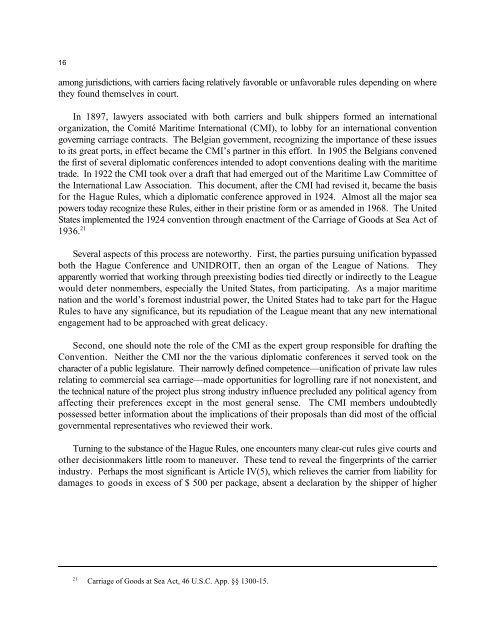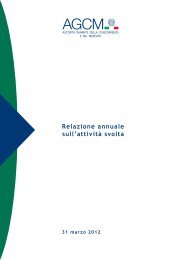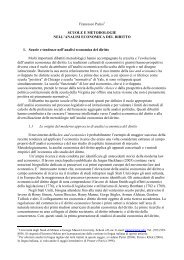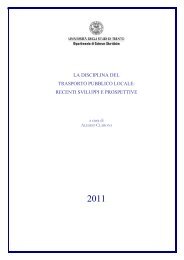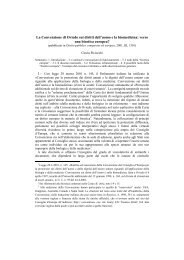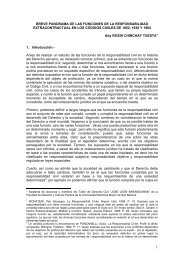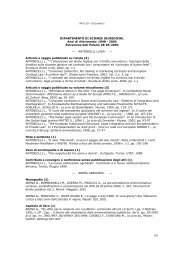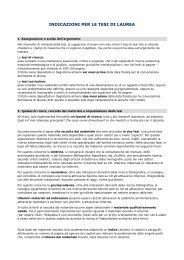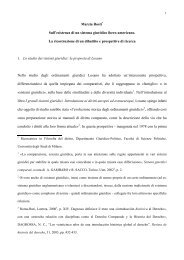16among jurisdictions, with carriers fac<strong>in</strong>g relatively favorable or unfavorable rules depend<strong>in</strong>g on wherethey found themselves <strong>in</strong> court.In 1897, lawyers associated with both carriers <strong>and</strong> bulk shippers formed an <strong>in</strong>ternationalorganization, the Comité Maritime <strong>International</strong> (CMI), to lobby for an <strong>in</strong>ternational conventiongovern<strong>in</strong>g carriage contracts. <strong>The</strong> Belgian government, recogniz<strong>in</strong>g the importance <strong>of</strong> these issuesto its great ports, <strong>in</strong> effect became the CMI’s partner <strong>in</strong> this effort. In 1905 the Belgians convenedthe first <strong>of</strong> several diplomatic conferences <strong>in</strong>tended to adopt conventions deal<strong>in</strong>g with the maritimetrade. In 1922 the CMI took over a draft that had emerged out <strong>of</strong> the Maritime Law Committee <strong>of</strong>the <strong>International</strong> Law Association. This document, after the CMI had revised it, became the basisfor the Hague Rules, which a diplomatic conference approved <strong>in</strong> 1924. Almost all the major seapowers today recognize these Rules, either <strong>in</strong> their prist<strong>in</strong>e form or as amended <strong>in</strong> 1968. <strong>The</strong> UnitedStates implemented the 1924 convention through enactment <strong>of</strong> the Carriage <strong>of</strong> Goods at Sea Act <strong>of</strong>1936. 21Several aspects <strong>of</strong> this process are noteworthy. First, the parties pursu<strong>in</strong>g unification bypassedboth the Hague Conference <strong>and</strong> UNIDROIT, then an organ <strong>of</strong> the League <strong>of</strong> Nations. <strong>The</strong>yapparently worried that work<strong>in</strong>g through preexist<strong>in</strong>g bodies tied directly or <strong>in</strong>directly to the Leaguewould deter nonmembers, especially the United States, from participat<strong>in</strong>g. As a major maritimenation <strong>and</strong> the world’s foremost <strong>in</strong>dustrial power, the United States had to take part for the HagueRules to have any significance, but its repudiation <strong>of</strong> the League meant that any new <strong>in</strong>ternationalengagement had to be approached with great delicacy.Second, one should note the role <strong>of</strong> the CMI as the expert group responsible for draft<strong>in</strong>g theConvention. Neither the CMI nor the the various diplomatic conferences it served took on thecharacter <strong>of</strong> a public legislature. <strong>The</strong>ir narrowly def<strong>in</strong>ed competence—unification <strong>of</strong> private law rulesrelat<strong>in</strong>g to commercial sea carriage—made opportunities for logroll<strong>in</strong>g rare if not nonexistent, <strong>and</strong>the technical nature <strong>of</strong> the project plus strong <strong>in</strong>dustry <strong>in</strong>fluence precluded any political agency fromaffect<strong>in</strong>g their preferences except <strong>in</strong> the most general sense. <strong>The</strong> CMI members undoubtedlypossessed better <strong>in</strong>formation about the implications <strong>of</strong> their proposals than did most <strong>of</strong> the <strong>of</strong>ficialgovernmental representatives who reviewed their work.Turn<strong>in</strong>g to the substance <strong>of</strong> the Hague Rules, one encounters many clear-cut rules give courts <strong>and</strong>other decisionmakers little room to maneuver. <strong>The</strong>se tend to reveal the f<strong>in</strong>gerpr<strong>in</strong>ts <strong>of</strong> the carrier<strong>in</strong>dustry. Perhaps the most significant is Article IV(5), which relieves the carrier from liability fordamages to goods <strong>in</strong> excess <strong>of</strong> $ 500 per package, absent a declaration by the shipper <strong>of</strong> higher21Carriage <strong>of</strong> Goods at Sea Act, 46 U.S.C. App. §§ 1300-15.
22value. <strong>The</strong> cap applies except when <strong>in</strong>jury stems from the carrier’s know<strong>in</strong>g or recklessmisconduct. 23This limitation is not absolute, as passengers <strong>and</strong> shippers rema<strong>in</strong> free to negotiate for greaterliability. But the drafters probably appreciated that a right to dicker over liability would have littlepractical effect. <strong>The</strong>y easily could have expected that specialist <strong>in</strong>surance firms normally wouldprovide this protection at a lower cost than could carriers. <strong>The</strong> cartelized nature <strong>of</strong> the <strong>in</strong>dustry madeit likely that the shipper would bear the cost <strong>of</strong> additional coverage whether obta<strong>in</strong>ed from the carrieror a third party. At a m<strong>in</strong>imum, the transaction costs associated with negotiat<strong>in</strong>g anyth<strong>in</strong>g differentfrom the st<strong>and</strong>ard liability term would deter shippers from seek<strong>in</strong>g a departure except <strong>in</strong> cases wherethe benefit derived from carrier (as opposed to third party) liability exceeded by some substantialamount the difference <strong>in</strong> cost between procur<strong>in</strong>g <strong>in</strong>surance <strong>and</strong> shar<strong>in</strong>g the burden with the carrier.Other provisions also reflect the carriers’ <strong>in</strong>terests. Article IV(2)(a) provides them with ancomplete defense for all liability caused by faults <strong>in</strong> navigation, even when the ship’s capta<strong>in</strong> serves24as the carrier’s employee. Article IV(2) lists other conditions, such as war, weather, <strong>and</strong> laborunrest, that would free carriers from liability <strong>and</strong> forbids the imposition <strong>of</strong> liability without fault. 25F<strong>in</strong>ally, Article III(6) gives the recipients <strong>of</strong> cargo only a limited time to compla<strong>in</strong> about damage afterthey take possession. Failure to compla<strong>in</strong> immediately, <strong>in</strong> the case <strong>of</strong> apparent damage, or with<strong>in</strong>three days, <strong>in</strong> all other cases, results <strong>in</strong> a legal presumption that the goods arrived <strong>in</strong> good condition.26Shippers then have a year to sue. As with Article IV(5), carriers rema<strong>in</strong> free to contract for greaterobligations than those imposed by the Hague Rules, but may not contract away those duties imposedby the Rules. 27One could challenge my characterization <strong>of</strong> these provisions as pro-carrier. None may favorcarriers as much as a legal regime that allows carriers an unrestricted right to contract out <strong>of</strong> mostif not all liability. But by the end <strong>of</strong> the n<strong>in</strong>eteenth century, freedom <strong>of</strong> contract with respect to seacarriage was wan<strong>in</strong>g <strong>and</strong> some form <strong>of</strong> <strong>in</strong>dustry regulation seemed <strong>in</strong>evitable. <strong>The</strong> limits on liabilityfound <strong>in</strong> the Hague Rules seem at least as hospitable, <strong>and</strong> probably better, than those that carriersmight have confronted had the <strong>in</strong>ternational process not cut short national legislative developments.Further evidence that the Hague Rules favor sea carriers comes from subsequent efforts byshippers to overturn the regime. At the <strong>in</strong>itial suggestion <strong>of</strong> Chile, a country that relies heavily on1722Hague Rules Art. IV(5).<strong>The</strong> Protocol to Amend the 1924 Convention for the <strong>Unification</strong> <strong>of</strong> Certa<strong>in</strong> Rules <strong>of</strong> LawRelat<strong>in</strong>g to Bills <strong>of</strong> Lad<strong>in</strong>g, Feb. 23, 1968 [here<strong>in</strong>after cited as Visby Rules], <strong>in</strong>creased the monetary value <strong>of</strong> Article IV(5)’slimit. Many important jurisdictions, <strong>in</strong>clud<strong>in</strong>g the United K<strong>in</strong>gdom, Canada, South Africa, France <strong>and</strong> Belgium, apply theVisby Rules, but the United States still adheres to the unamended Hague Rules.23Hague Rules Art. IV(5).24Hague Rules Art. IV(2)(a). Carrier do have an obligation to exercise care <strong>in</strong> prepar<strong>in</strong>g the vessel for seaworth<strong>in</strong>ess<strong>and</strong> <strong>in</strong> select<strong>in</strong>g their agents <strong>and</strong> servants, <strong>in</strong>clud<strong>in</strong>g the master. Id. Art. III(1).25Id. Art. IV(2).26Id. Art III(6). <strong>The</strong> Visby rules permits owners <strong>of</strong> damaged cargo to br<strong>in</strong>g actions for <strong>in</strong>demnity after the one-yearperiod has expired. Visby Rules Art. III(6bis).27Hague Rules Arts. III(8), V.


